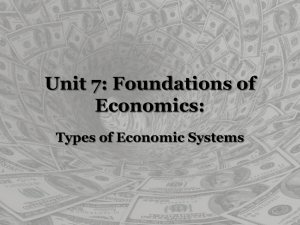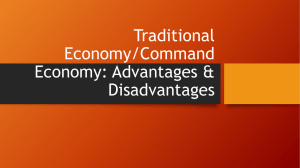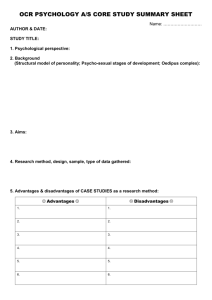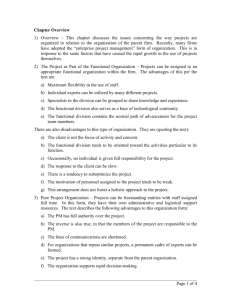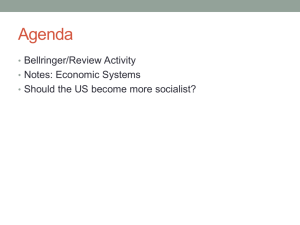File
advertisement
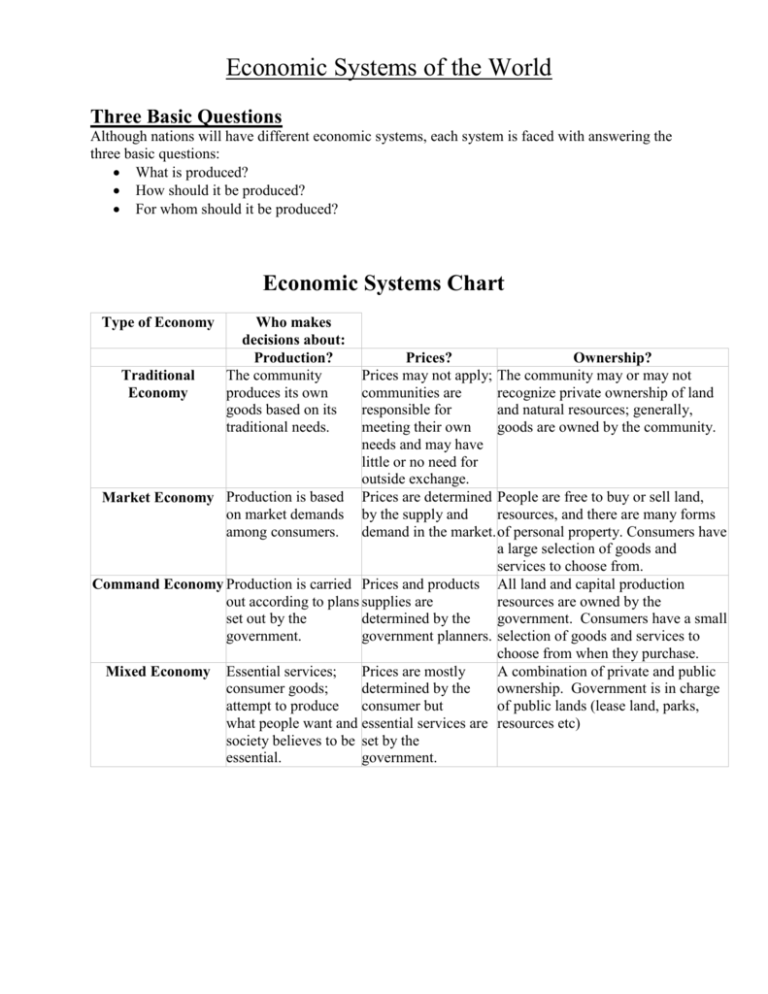
Economic Systems of the World Three Basic Questions Although nations will have different economic systems, each system is faced with answering the three basic questions: What is produced? How should it be produced? For whom should it be produced? Economic Systems Chart Type of Economy Who makes decisions about: Production? The community produces its own goods based on its traditional needs. Prices? Ownership? Prices may not apply; The community may or may not communities are recognize private ownership of land responsible for and natural resources; generally, meeting their own goods are owned by the community. needs and may have little or no need for outside exchange. Market Economy Production is based Prices are determined People are free to buy or sell land, on market demands by the supply and resources, and there are many forms among consumers. demand in the market. of personal property. Consumers have a large selection of goods and services to choose from. Command Economy Production is carried Prices and products All land and capital production out according to plans supplies are resources are owned by the set out by the determined by the government. Consumers have a small government. government planners. selection of goods and services to choose from when they purchase. Prices are mostly A combination of private and public Mixed Economy Essential services; consumer goods; determined by the ownership. Government is in charge attempt to produce consumer but of public lands (lease land, parks, what people want and essential services are resources etc) society believes to be set by the essential. government. Traditional Economy Types of Economic Systems Traditional Economy A traditional economy answers the three basic questions according to tradition. In such a system, things are done “the way they have always been done”. Economic decisions are based on customs and beliefs—often religious—handed down from generation to generation. If you lived in a traditional economic system, your parents would teach you to perform the same tasks that they learned from their parents. As a male, for example, if your father was a fisherman, you would become a fisherman. Advantages An advantage of living in a traditional economy is that you usually know what is expected of you. In addition, family and community ties are usually very strong. Disadvantages Disadvantages include an economy in which change is discouraged and perhaps even punished, and the methods of production are often inefficient. Consequently, choices among consumer goods are rare. Location Tradition economies exist in some extent in very limited parts of the world today. The Inuit of North America, the San of the Kalahari in Africa, and the Aborigines of Australia are organized into traditional economic systems. Command Economy The pure command economy is somewhat similar to the traditional economy in that the individual has little, if any, influence over how the basic economic questions answered. In a command or controlled system, however, government leaders—not tradition—control the factors of production and, therefore, make all the decisions about their use. If you live in a command economy, you will be paid according to what central planners decide. The government guides people into certain jobs. Advantages An advantage of a controlled economy is the speed with which resources can be rerouted. If war is likely, the central planning agency can halt all manufacturing of civilian goods and channel the factors of production into making strictly military goods. Disadvantages Disadvantages include a lack of incentives to work hard or to show inventiveness, as well as a lack of consumer choices. Because the government sets workers salaries, there is no reason to work efficiently or smartly. Location Only a few countries in the world today still have much of a command economy. North Korea and the Peoples Republic of China are the two main examples because so much economic activity there is government-plant. Market Economy The opposite of a pure command economy is a pure market economy – also called capitalism. In a market system, economic decisions are not made by the government, but by individuals looking out for their own and their families’ best interests. A limited government makes it possible for individuals to decide for themselves the answers to the three basic questions. Individuals own the factors of production, and therefore choose what to produce and how to produce it. Advantages In a market economy people have freedoms – to choose a career, to spend or not spend their income as they wish, to own private property, to take risks and earn profits. In addition, the existence of competition provides consumers in a market economy with a wide array of goods and services from which to choose, as well as an efficient system of determining how much they cost. Disadvantages A disadvantage of a pure market system involves concern of those too young, too old, or too sick to work. Many fear that survival for these people would be difficult unless the government, churches, family members, or other organizations step in to provide goods and services. A market economy also relies on some individuals not succeeding in order to function. Mixed Economy A mixed economy combines basic elements of a pure market economy and a command economy. Most countries of the world have a mixed economy in which private ownership of property and individual decision-making are combined with government intervention and regulations.
